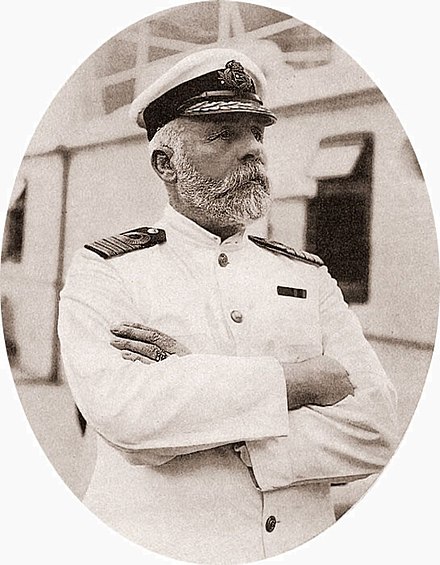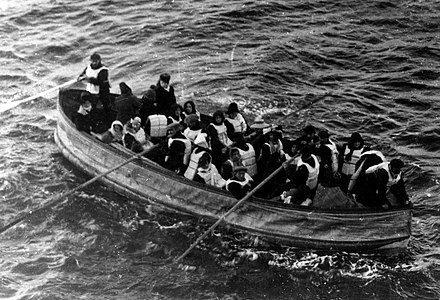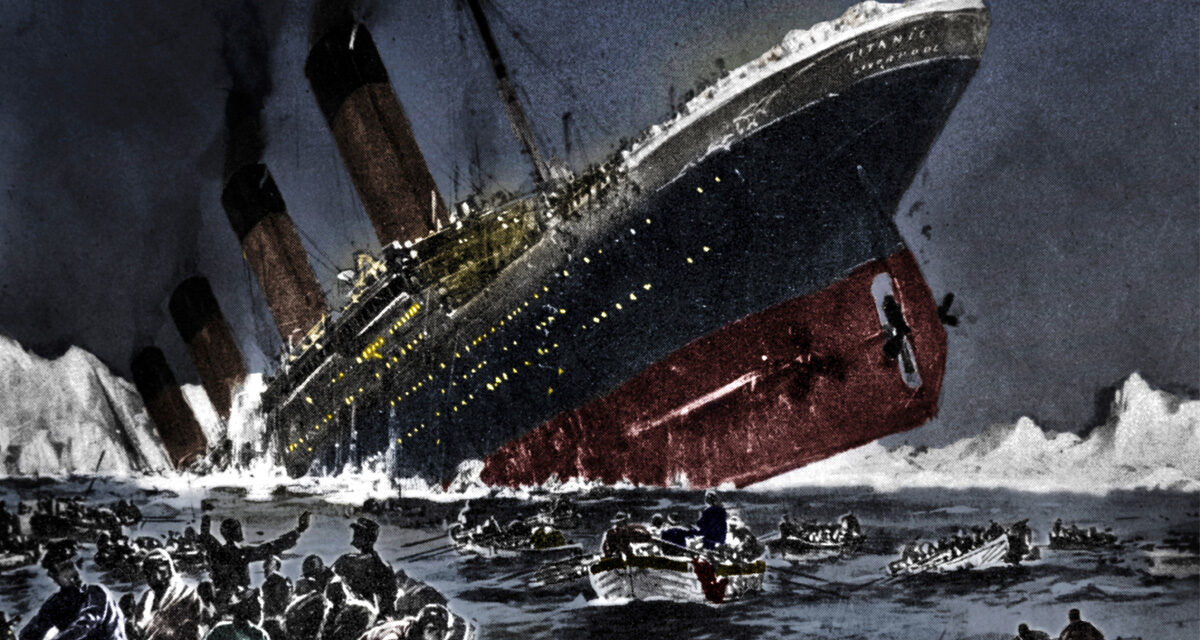One hundred and twelve years ago, on its maiden voyage, the Titanic, the largest passenger ocean liner of its time, sank.
Its creators considered it unsinkable due to its compartmentalized hull. On April 14, 1912, however, disaster struck after the ship hit an iceberg.
The largest cruise ship of its time was the RMS Titanic, worthy of its namesake, the titans, who came to this world as the children of Gaia and Uranus as the embodiment of primal power. And when Uranus, fearing his power, forced his children into the depths of the earth, Kronos, the youngest Titan, took revenge on his father and cut off his manhood with a sickle, which he threw into the sea. Then the sky separated from the earth, and around the manhood thrown into the sea, the water bubbled up so that it swallowed all the objects floating on its surface.
The RMS Titanic also met this fate.
Three ships made up the Olympic boat class:
the first to be built was RMS Olympic, the second to be born was RMS Titanic, and the youngest, RMS Gigantic, whose name was changed to RMS Britannic after the death of its older brother. All three were characterized by titanic dimensions.
The width of the Titanic at the waterline was 28 meters and its length was 270 meters, which made it close to the size of the 300-meter-high Eiffel Tower. But if we talk about the height of the ship, it was 56 meters, which is equivalent to an 18-story apartment building. Of course, this data must be understood from the underwater ridge to the top of the chimneys, but it can still be said to be impressive. Three million rivets were used to fasten the steel plates that make up its casing.
Real, titanic data, worthy of its namesake, which embodies primeval strength.
It was considered unsinkable because it had a double hull, and watertight compartments were built between the two layers. If one of the compartments is damaged, the water will naturally flow in there, but it will not get any further. According to the engineers' calculations, the ship can withstand damage to four adjacent compartments, but not five. This is exactly what caused the loss of the Titanic, as the iceberg split open five compartments. In addition, it was so unfortunate that it smashed the inner walls of several compartments, so the seawater also flowed into the interior of the ship.
But let's not run so far ahead!
The titanic-scale ship was launched on May 31, 1911 at the Harland and Wolff factory in Belfast, but it left for its trial voyage almost a year later, on April 2, 1912, in Southampton, England. From there, at noon on April 10th, he left for Cherbourg, France. Even then, the more superstitious sailors frowned and noted as a bad omen that at the opening of the first journey, which had already started with passengers and cargo, i.e. still in the port of Southampton, it almost collided with another ocean liner, the New York. It ran into open water touching Queenstown, Ireland. After that, three days of calm, uneventful sailing followed. There was a light breeze over the ocean, so the weather was perfect.
The first worrisome signs came on the eve of the disaster, as the Titanic received several signals from ships traveling in the area that there were larger floating icebergs along its route.
However, Captain Edward John Smith ignored these signals, all he did was order a sailor to the ship's observation mast. Incidentally, Captain Smith was asked to command the Titanic as one of the most experienced captains in the world. Previously, he was the captain of Titanic's sister ship, Olympic, but on September 20, 1911, he collided with a British warship, HMS Hawke. Both ships were badly damaged. Captain Smith subsequently announced his retirement.
He boarded the Titanic on April 10, 1912, which would have been his last voyage. And indeed, it was…

Edward John Smith is the captain of the TITANIC (source: Wikipedia)
The floating iceberg was discovered on April 14, twenty minutes before midnight, by Frederick Fleet, a sailor on duty at the top of the observation mast, who immediately notified the command bridge. First Officer William Murdoch then gave instructions to turn the ship to port and put the engines in reverse. However, the titanic-sized, full-throttle scooter could only turn in too large an arc, so a collision was inevitable.
The iceberg brushed the entire right side of the ship, but the passengers only felt a slight jolt from the collision, they didn't even pay attention, the band continued playing in the bar, the champagne was flowing, and the dancing was going on.
Thomas Andrews, chief designer of the three Olympic-class ships, traveled on the Titanic. He was accommodated in luxury cabin number 36. After the collision, he immediately went up to the bridge, and based on the information he received about the injuries, he calculated that the ship was unsalvageable and would sink. Captain Smith knew that there were not enough lifeboats for the number of passengers, so he ordered that only women and children could be put in the boats first, men could only follow if there was still room.
The first distress signal was given by the Titanic at quarter to one in the morning.
The closest to the agonizing giant was the ship Californian, except that its radio operator was asleep and did not wake up to the distress signals. The flares fired from the Titanic were not dealt with aboard the Californian either. Although they saw them from a distance, they did not understand why they were fired.
However, the steamer named Carpathia, which was much further away, received the distress signals and immediately headed towards the sinking Titanic at full steam. However, Captain Arthur Rostron's ship was too far away and did not reach the scene in time.
The Titanic's first lifeboat, number seven, was launched with 28 people at three-quarter time. Only women and children were allowed to board from the left side of the ship's hull, and men could also go on the other side. The last lifeboat was launched at two o'clock, almost at the last moment. As the iceberg split open the front of the ship, ten minutes later the prow dug into the sea at a steep angle due to the rushing water, and accordingly the stern deck rose into the sky. The lights went out everywhere, and when almost half of the hull was standing out of the water, the Titanic broke under its own weight.
Ten minutes later, at 2:20 a.m., the ship sank.
The Carpathia arrived hours later. By that time, everyone who got into the water had died. Only those in the lifeboats were safe.

Survivors in the lifeboat of the Titanic (source: Wikipedia)
The Carpathia picked up the first boat, number two, at a quarter to five in the morning, and the last, number 12, four hours later, around eight in the morning.
We cannot go without saying that the ship's doctor of the Carpathia was Hungarian. Many people owe their lives to Árpád Lengyel.
After the tragedy of the Titanic, its sister ship, the Gigantic, whose name was also chosen from Greek mythology, was immediately renamed Britannic. However, he could not avoid his fate either, as he sank in the Aegean Sea due to mines laid by the German submarine U-79 during the First World War.
The tragedy of the Titanic caused a huge response, it was on the front pages of newspapers worldwide.
However, it soon became a symbol that went beyond the event itself. The turn of the previous century was characterized by the enthusiastic zeal of faith in science. In countries belonging to Western culture, the view prevailed that through lightning-fast technical development, man can not only conquer nature, but can also permanently dominate it. However, the destruction of the Titanic gave an answer to this attitude, which can almost be said to be conceited, and suggested that people should stop! You can't compete with the power of nature, you can't measure yourself against it!
It is no coincidence that in May 1912, i.e. not long after the tragedy, István Fejes wrote this in his poem Titanic:
"There are no giants, only the big sky. / And below it is the deep sea, / But it was small and still small / Between the sea and the sky is – man!” (Sunday Gazette, May 26, 1912)
Featured Image: Print Collector | Source: Getty Images













